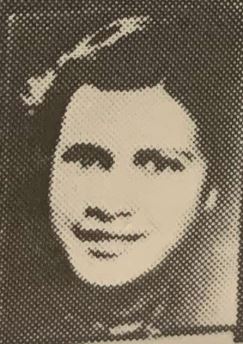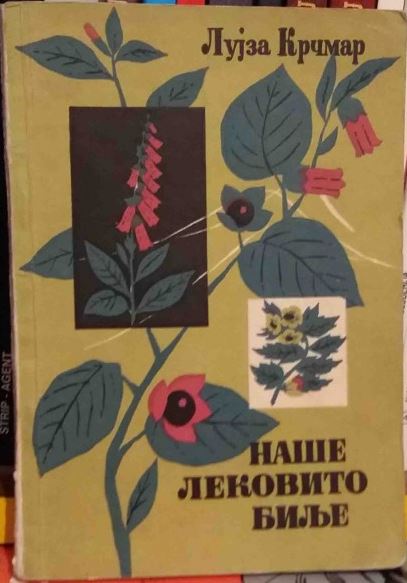
brochure "Partizanski spomenik u Mostaru" (1980)
book “Spomenica Mostara 1941-1945.”
another document or proof of the memorial stone (e.g., a photograph).
Radojka S. KRČMAR
RADOJKA (BERGMAN L.) KRČMAR, daughter of STJEPAN, born on February 28, 1925 in Varaždin. She lived with her family in Mostar, a student at the Gymnasium. Niece of the slain Dr. Berta Bergman, cousin of the fallen fighter Mihajlo Kon. A member of the League of Communist Youth (SKOJ) since 1940, secretary of the SKOJ core. She joined the People’s Liberation Army and Partisan Detachments in March 1942 in Eastern Herzegovina, and after the Chetnik coup, she took refuge in Mostar. Arrested by the Italians with a group of young women in 1943 and sent to the Prevlaka camp, with a farewell from the entire Mostar, and then to the Italian concentration camp Visco di Udine. After the capitulation of fascist Italy in September 1943, the prisoners were released. One group of Herzegovinians, including Radojka, crossed the Slovenian border and joined the Slovenian brigade “Ljubo Šercer.” She died on December 20, 1943, near Kočevje in Slovenia.
Radojka is the daughter of Mrs. Lujza Bergman (Bergmann)-Krčmar, a pharmaceutical collaborator in Mostar, born in 1897 in Kaknja. She completed her pharmacy studies in Vienna in 1922. Radojka’s mother, Lujza, is the sister of Dr. Berta Bergman, who assisted the National Liberation War (NOP) from 1941 by sending medical supplies to the partisans, for which she was arrested multiple times. Lujza joined the NOP in 1941 and also sent medical supplies and medications to partisan units. The Ustasha arrested her several times but could not prove her involvement in the NOP. In October 1944, she defected to Dalmatia where she joined the People’s Liberation Army (NOV) and served as a pharmacist for the 29th Herzegovinian Division.
From Zdenka Kesterčaner’s letter in 1946: “In June 1943, Ms. ph. Lujza Krčmar-Bergman fled from Mostar to Dubrovnik with her two children. Although there was no need for an assistant in the pharmacy under those wartime conditions, Zdenka took her in for work and provided her with accommodation, offering her the use of the kitchen, until their house in Gruž was bombed in the fall of 1943. ‘From the very beginning, I knew what she had endured, the persecutions she had faced because of her brother, an engineer and communist from the Spanish Civil War, whom the Ustasha executed in 1941. I knew and often consoled her because of her brother and daughter, who were in the Mamula and Visco camps and perished in the fight in Slovenia. Lujza was taken from my house to prison in Dubrovnik and returned to us. She left my pharmacy with her children in October 1944 to join the partisan forces.'” (tačno.net)
From the memories of Zora Kešelj, a teacher from Mostar: “I had long conversations with all the comrades from Mostar in that brigade. What stood out the most was my last conversation with Radojka Krčmar. I knew her as a cheerful and lively girl full of enthusiasm and revolt against the occupiers. In those moments, I didn’t notice that her cheerfulness had faded, but the shadow of fatigue and melancholy on her face deeply engraved in my memory. Whether such expression was a result of the words she said to me – that she had a premonition of her death, or if it was her sadness over the memory of her mother, I couldn’t say even today. But I remember her exact words: ‘Zorka, if you survive, go to my mother and tell her that as a mother, she can be proud of her daughter because she has not tainted her life in any way…’ Fifteen days after parting with Radojka, I learned from some couriers from the District Party Committee in Ribnica that she was killed on December 20, immediately after our parting.”
At the Partisan Memorial Cemetery in Mostar, alongside Radojka’s memorial plaque, there are two more plaques belonging to her aunt, Dr. Berta Bergman, and her cousin, Mihajlo Kon. Radojka Krčmar’s name was recorded on the memorial plaque at Mostar Gymnasium after the war. The plaque disappeared without a trace during the war events of 1992-1995. In 1999, a Holocaust monument was erected at the Jewish cemetery in Mostar, which also bears Radojka’s name.
https://core.ac.uk/download/pdf/286765836.pdf; https://poskok.info/mostarke-u-doba-okupacije-sloboda-nije-stigla-iz-bajke/; grupa autora (1986): Hercegovina u NOB 4. dio, Beograd; Seferović, Mensur: Mostarski kolopleti, edicija “Mostar u borbi za slobodu”, knjiga 8, Mostar; Konjhodžić, Mahmud (1981): “Mostarke”: fragmenti o revolucionarnoj djelatnosti i patriotskoj opredjeljenosti žena Mostara, o njihovoj borbi za slobodu i socijalizam, Opštinski odbor SUBNOR-a Mostar; http://www.most.ba/108/083.aspx ; grupa autora: Spomenica Mostara 1941-1945; https://www.tacno.net/novosti/pismo-iz-lopudskog-gubilista-u-okupirani-gruz/; Romano, dr Jaša: Jevreji Jugoslavije 1941 — 1945. žrtve genocida i učesnici NOR, Srboštampa, Beograd; Romano, dr Jaša (1972) Jevrejski istorijski muzej, Zbornik 2, Beograd; Romano, dr Jaša, Jevreji u logoru na Rabu i njihovo uključivanje u narodnooslobodilački rat
Photo of the memorial plaque: S. Demirović.
Do you have more information about this fighter? Share your stories and photographs. Let's keep the memory alive!






